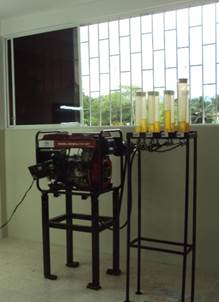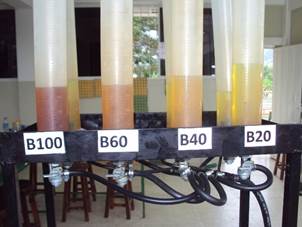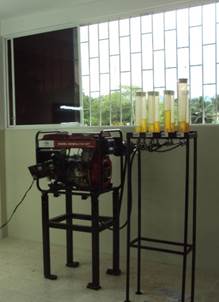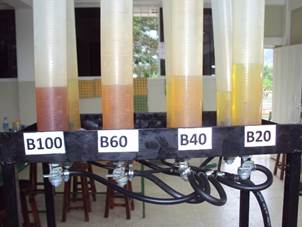Translate PaperOriginal Article http://opn.to/a/JphAc
http://opn.to/a/JphAcMathematical Model to Predict Biofuel Mixture Consumption in a Generator
MSc. Manuel Saltos-Giler [I] [*]
Mg. Gilberto Jarre-Cedeño [I]
Dr.C. Omar González-Cueto [II]
Dr.C. Elvis Lopéz-Bravo [II]
Dr.C. Mario Ignacio Herrera-Prat [III]
[I] Universidad Técnica de Manabí (UTM), Facultad de Ingeniería Agrícola, Portoviejo, Manabí, Ecuador.
[II] Universidad Central “Marta Abreu” de las Villas, Santa Clara, Villa Clara, Cuba.
[III] Universidad Agraria de La Habana, San José de las Lajas, Mayabeque, Cuba.
[*] Author for correspondence: Manuel Saltos-Giler, e-mail: manuelsaltos172@gmail.com
ABSTRACTThe need to replace fossil fuels is now a priority in the world. The biodiesel from non-edible crops is a line of work to apply in agricultural communities fundamentally. In this work the use of mixtures of diesel-biodiesel of castor oil in a 7.46 kW generator set with a diesel engine was studied. The behavior of different mixtures of diesel-biodiesel and pure diesel was studied at different loads of the generator set and the fuel consumption was measured as a response variable. A multiple linear regression model in the statistical program SSP was used to process the data. A mathematical model with an adjustment R2, able to predict the consumption for different mixtures and at different loads was obtained. In field conditions, its energy performance can be determined from the variables studied and thus, determine the consumption required in each case.
INTRODUCTIONThe use of biofuels is one of the current ways of replacing fossil fuels in the world. Researchers from different latitudes see it as a renewable and ecological resource for fuel, devote their effort in this regard and have discussed about it (Nahar y Dupont, 2012; Xuan et al., 2009). In the world, 30 billion liters per year are produced, which represents 19% of the world production of biofuels (Diop et al., 2013). Other authors have pronounced for the use of biodiesel in the diesel engine (Graboski y McCormick, 1998; Canakci y Van Gerpen, 2001; Rakopoulos et al., 2006a; Lin et al., 2006; Altın et al., 2001; İşcan y Aydın, 2012).
The use of biofuels in agricultural communities is a source to reduce costs and damage to the environment. Small-scale generator sets are an option of power service for isolated agricultural communities, to complement their services from biofuels obtained from surrounding crops. In this research, it was proposed to evaluate the use of biodiesel from castor oil in different mixing proportions and loads of the generator set, with the aim of establishing a fuel consumption model in the different work variables. The studies were carried out using a 7.46 kW power unit with a diesel engine of a cylinder as an experimental model. The work was carried out in the laboratories of the Facultad de Ingeniería Agrícola of the Universidad Técnica de Manabí located in Lodana. The analysis of the data was performed using the multiple regression method to obtain the mathematical model and 32 runs were carried out. This method was developed through the statistical computer program SSP. A mathematical model that represents the physical model was obtained. It allowed determining the relationships between the use of biodiesel mixtures, the electric charge and the fuel consumption and thus being able to predict the consumption within the range studied.
METHODSThe research was carried out in the laboratories of the Facultad de Ingeniería Agrícola of the Universidad Técnica de Manabí. In the study, a 7.46 kW power generator that uses a one-cylinder diesel engine was used as experimental model. Figure 1 shows the model and its installation and Table 1 shows the main characteristics of the engine.
Experimental DesignIn the experimental design, three variables to be evaluated were considered: fuel, electric charge of the group and hours of work. In the case of fuel, pure diesel was used for the mixtures of B0, B5, B10, B15, B20, B40, B60 and B100; in the electric charge, light bulbs with values between 0 and 500 W were used. To guarantee the reliability of the results, the data were taken considering each hour up to 40 working hours. A total of 32 variants were evaluated from the values of the different factors. The factors were coded for identification in the equation. Table 2 shows the factor and the code.
For the measurement of fuel consumption, 500 cm3 graduated cylinders were used. As shown in Figure 2, 8 specimens connected to the engine were mounted on the model using a flexible hose and a quick-closing valve to control the use of each mixture. In the change from one mixture to another, the power system was cleaned and the engine was operated with 300 cm3 of the variant to be used and from this the measurement was started.
Graduated cylinder used in the research.
For the installation of the power energy to be consumed, 10 W bulbs were used, placed as shown in Figure 3, taking into account that the load is known, it was only controlled by the wattmeter of the generator set, to take into account the losses in the circuit.
System of power charge used.
Statistical MethodologyThe data analysis was carried out using the multiple regression method to obtain the mathematical model. This method is developed through the SSP computer program. By this method it is possible to have different variables that taken together can serve as a satisfactory basis for the estimation of the desired variable, made by linear functions. For this purpose, the available variables are represented by Y, X1, X2, ....... Xk, and the problem of estimating Y is considered by means of a linear function of the remaining variables. If Y is designated as the variable, its estimated is obtained by means of the expression:
(1)
Coefficient of Determination of the RegressionThe coefficient of determination of the regression determines the degree of adjustment of the model, accepting as results, values greater than 0.9 (Hoel y Yuste, 1976).
Mathematical evaluation of Fischer Test. This is accomplished by means of Fischer Test from the comparison of the two types of errors "pure error" and "error due to lack of adjustment". If the Fischer coefficient calculated for the model is smaller than the tabulated one, the hypothesis that the determined mathematical model presents a good fit to the physical model is accepted. Fischer criterion is based on the comparison of the variance of the two types of errors cited above.
Independence of the VariablesIndependence is determined by the correlation matrix, if it is zero there is mismatch between the variables, which shows that each variable gives the model a different effect and that there is no effect of interaction between them, showing independence. If there is any value, the interaction in the model, must be studied and its incorporation to the model must be decided. The tabulated F is searched in the table with 0,95 percentile, according to the degrees of freedom of the numerator (K-1) and denominator (n-K). If the calculated F is less than the F of the table, the hypothesis that the variances are equal and therefore the mathematical model determined adequately represents the experimental model, is accepted.
RESULTS AND DISCUSSIONThe model that represents the fuel consumption based on diesel-biodiesel mixtures and the generator load is represented by the equation:
The coefficient of determination of the regression, R2 of the model, is 0.945. This value demonstrates the high degree of adjustment obtained, accepting that the model adequately describes the phenomenon represented. Therefore, it can be stated that the mathematical model represents the physical model studied with a confidence level of 95%.
The independence of the factors was determined by the correlation matrix. Table 3 shows the correlation coefficients between the factors studied. The correlation between the factors is zero, which shows that each factor gives the model a different effect and that there is no effect of interaction between them, and independence is demonstrated.
Evaluation of Fischer TestThe tabulated F was determined in Fischer F table with 0.95 percentile, according to the degrees of freedom of the numerator and the denominator. The value is 161.146 and the calculated F is 77.84.t The F calculated is lower that the F of the table, so the hypothesis that the variances are equal and, therefore, the mathematical model determined adequately represents the experimental model is accepted.
When analysing the factors in the model, it is obtained that, x1, which represents the proportion of the diesel-biodiesel mixtures, is presented with a positive sign and with a coefficient of 3.44. It indicates that, with the increase in the percentage of biodiesel in the mix, increases fuel consumption. This is the strongest factor in the model, in contribution to the response with 91.8%. This result coincides with Pérez-Sánchez et al (2015), mainly conditioned by the lowering caloric value of the mixture by adding the biodiesel from castor oil which is 8,553 kcal/kg (measured in the laboratories of the Pontificia Universidad Católica del Ecuador, in Ibarra). Nevertheless, Armando et al., (2015) report, in California, values of 8,964 kcal/kg, smaller than diesel in the two cases, which is 10,552 kcal/kg. Regarding calorific power, Altın et al. (2001) and İşcan and Aydın (2012), referred that biodiesel produced from other sources such as cotton, soy, palm, sunflower, show no significant changes in this value. Other physical factors influence consumption, such as viscosity and density. In the case of biodiesel, it is 52.2 cp and 0.950 g/cm3 (kinematic viscosity 5.5 cSt), respectively. For diesel, kinematic viscosity is 3.2 cSt and density of 0.850 g/cm3. The viscosity is higher in biodiesel than in diesel, which influences the movement of the fluid through the pump and the injector. Researches have reported that the properties that present the greatest variation between biodiesel and diesel are density, cetane number, calorific value and, in greater proportion, viscosity of the fuel (Lin et al., 2006; Rakopoulos et al., 2006b; Scarpa and Guerci, 1982). The model has a linear nature and referred to that, Abdalla (2018) stated that the results for the properties of density and viscosity in the mixtures strongly indicate a linear increase when increasing the percentage of B100 in the mixture.
The factor x2, which represents the power load to the generator's electrical system, is presented with a positive value with a coefficient of 0.162, which indicates that an increase in the load on the generator brings about an increase in fuel consumption, what was expected, once the system requires more energy. Although the weight of this factor is lower in its influence on consumption in proportion to x1, it is considered for consumption in the range studied. The factor has a weight in the response of 7.2% much lower than 91.8% of the factor of diesel-biodiesel mixtures.
The factor x3 represents the number of hours worked in each run; two levels were taken at 20 hours of work and at 40 hours. In the resulting model, this factor has the least influence on consumption with a coefficient of 0.078 and with a positive sign, which means that the increase in working hours shows an increase in fuel consumption. The increase in fuel consumption by this factor is 1%, which is considered non-representative as a study factor.
In general, with the model obtained, the amount of fuel needed for a given power and a selected biodiesel mixture can be planned, using the generator set of the experimental model within the ranges studied.
CONCLUSIONSThe model was obtained according to the variables studied, which allows to determine the consumption from the power charge and the mixture of diesel-biodiesel used.
The factor x1 that represents the percentage of biodiesel mixtures is the one that has the greatest influence on fuel consumption with a 91.8% weight in the fuel consumption of the engine.
The factor x2, which represents the electric power load to which the generator is subjected, has a weight in the fuel consumption of 7.2%.
Traducir DocumentoArtículo Original http://opn.to/a/JphAc
http://opn.to/a/JphAcModelo matemático para la predicción del consumo de mezclas de biocombustible en un grupo electrógeno
MSc. Manuel Saltos-Giler [I] [*]
Mg. Gilberto Jarre-Cedeño [I]
Dr.C. Omar González-Cueto [II]
Dr.C. Elvis Lopéz-Bravo [II]
Dr.C. Mario Ignacio Herrera-Prat [III]
[I] Universidad Técnica de Manabí (UTM), Facultad de Ingeniería Agrícola, Portoviejo, Manabí, Ecuador.
[II] Universidad Central “Marta Abreu” de las Villas, Santa Clara, Villa Clara, Cuba.
[III] Universidad Agraria de La Habana, San José de las Lajas, Mayabeque, Cuba.
[*] Autor para correspondência: Manuel Saltos-Giler, e-mail: manuelsaltos172@gmail.com
RESUMENLa necesidad de lograr sustituir los combustibles fósiles constituye actualmente una prioridad en el mundo. El biodiesel a partir de cultivos no comestibles, es una línea de trabajo para aplicar en comunidades agrícolas fundamentalmente. En el trabajo se estudia el uso de mezclas de diesel-biodiesel de aceite de higuerilla en un grupo electrógeno de 7.46 kW con un motor diesel. Se estudió el comportamiento de diferentes mezclas de diesel-biodiesel y diesel puro a diferentes cargas del grupo electrógeno y se midió el consumo de combustible como variable respuesta. Los datos fueron elaborados por un modelo de regresión lineal múltiple en el programa estadístico SSP. Se obtuvo un modelo matemático con un ajuste R2, capaz de predecir el consumo para diferentes mezclas y a diferentes cargas. En condiciones de campo se puede determinar el desempeño energético del mismo a partir de las variables estudiadas y determinar así el consumo necesario en cada caso.
INTRODUCCIÓNEl uso de los biocombustibles constituye una de las vías actuales para la sustitución de combustibles fósiles en el mundo. Investigadores de diversas latitudes lo ven como un recurso renovable y ecológico para el combustible y dedican su esfuerzo en tal sentido y se han pronunciado al respecto (Nahar y Dupont, 2012; Xuan et al., 2009). En el mundo se producen 30 mil millones de litros por año, lo que representa 19 % de la producción mundial de biocombustibles (Diop et al., 2013). Otros autores se han pronunciado por la utilización del biodiesel en el motor diésel (Graboski y McCormick, 1998; Canakci y Van Gerpen, 2001; Lin et al., 2006; Rakopoulos et al., 2006a; Altın et al., 2001; İşcan y Aydın, 2012).
El uso de los biocombustibles en las comunidades agrícolas constituye una fuente con vista a disminuir los costos y el daño al medio ambiente. Los grupos electrógenos de pequeño formato constituyen una opción para las comunidades agrícolas aisladas del servicio eléctrico, para complementar sus servicios a partir de biocombustibles obtenidos de los cultivos del entorno. En la investigación se propone evaluar el uso del biodiesel a partir del aceite de higuerilla en diferentes proporciones de mezcla y cargas del grupo electrógeno, con el objetivo de establecer un modelo de consumo de combustible en las diferentes variables de trabajo. Los estudios se realizaron utilizando como maqueta experimental un Grupo Electrógeno de 7,46 kW de potencia con un motor diésel de un cilindro, los trabajos se realizaron en los laboratorios de la Facultad de Ingeniería Agrícola de la Universidad Técnica de Manabí situados en Lodana. Se establecieron 32 corridas y el análisis de los datos se realizó empleando el método de regresión múltiple para obtener así el modelo matemático. Este método se desarrolla mediante el programa estadístico de computación SSP. Se obtiene un modelo matemático que representa al modelo físico y permite determinar las relaciones entre el uso de mezclas de biodiesel, la carga eléctrica y el consumo de combustible y así poder predecir el consumo dentro del rango estudiado.
MÉTODOSLa investigación se realizó en los laboratorios de la Facultad de Ingeniería Agrícola de la Universidad Técnica de Manabí. En el trabajo se utilizó como maqueta experimental un grupo electrógeno de 7,46 kW de potencia que utiliza un motor diésel de un cilindro. En la Figura 1 se muestra la maqueta y su instalación y en la Tabla 1 se muestran las principales características del motor.
Maqueta experimental utilizada.
Diseño de experimentoEn el diseño de experimento se consideraron tres variables a evaluar, el combustible, la carga eléctrica del grupo y las horas de trabajo. En el caso del combustible se usó diésel puro para las mezclas de B0, B5, B10, B15, B20, B40, B60 y B100; en la carga eléctrica se utilizaron bombillas con valores entre 0 y 500 W. Para garantizar la fiabilidad de los resultados, los datos se tomaron considerando cada una hora hasta 40 horas de trabajo. Se evaluaron un total de 32 variantes a partir de los valores de los distintos factores. Los factores fueron codificados para su identificación en la ecuación, a continuación en la Tabla 2 se muestra el factor y el código.
Para la medición del consumo de combustibles se utilizaron probetas graduadas de 500 cm3. Como se observa en la Figura 2 se montaron en la maqueta 8 probetas conectadas al motor mediante manguera flexible y con una válvula de cierre rápido para controlar el uso de cada mezcla. En el cambio de una mezcla a otra se limpió el sistema de alimentación y se procedió hacer funcionar el motor con 300 cm3 de la variante a utilizar y a partir de este se comenzó la medición.
Probetas utilizadas en la investigación.
Para la instalación de la energía eléctrica a consumir se utilizaron bombillas de 10 W, colocadas como se muestra en la Figura 3, teniendo en cuenta que la carga es conocida solo se controló mediante el vatímetro o multímetro del grupo electrógeno, para tener en cuenta las pérdidas en el circuito.
Sistema de carga eléctrica empleado.
Metodología estadísticaEl análisis de los datos se realizó empleando el método de regresión múltiple para obtener así el modelo matemático. Este método se desarrolla mediante el programa de computación SSP.
Por este método es posible tener diferentes variables que tomadas conjuntamente pueden servir como base satisfactoria de la estimación de la variable que se desea, realizado mediante funciones lineales. Con este fin se representan por Y, X1, X2,........Xk, las variables disponibles y se considera el problema de estimar Y por medio de una función lineal de las variables restantes. Si se designa Y como la variable, su estimación se obtiene mediante la expresión:
(1)
Coeficiente de determinación de la regresiónDetermina el grado de ajuste del modelo, aceptándose como resultados, valores mayores de 0,9 (Hoel y Yuste, 1976).
Evaluación matemática de la docima de Fischer: se realiza mediante la docima de Fischer a partir de la comparación de los dos tipos de errores “el error puro” y “el error por falta de ajuste”; si el coeficiente de Fischer calculado para el modelo es menor que el tabulado, se acepta la hipótesis de que el modelo matemático determinado presenta un buen ajuste al modelo físico. El criterio de Fischer se basa en la comparación de la varianza de los dos tipos de errores citados anteriormente.
Independencia de las variablesLa independencia se determina por la matriz de correlación, si es cero hay incorrelación entre las variables, lo que demuestra que cada variable aporta al modelo un efecto diferente y que no existe efecto de interacción entre ellas, quedando demostrado la independencia. De existir algún valor, se debe estudiar la interacción en el modelo y decidir su incorporación a éste. La F tabulada se busca en la tabla con 0,95 percentil, según los grados de libertad del numerador (K-1) y del denominador (n-K). Si la F calculada es menor que la F de la tabla se acepta la hipótesis de que las varianzas son iguales y por tanto el modelo matemático determinado representa adecuadamente al modelo experimental.
RESULTADOS Y DISCUSIÓNEl modelo que representa el consumo de combustible en función de las mezclas de diesel-biodiesel y la carga del generador del grupo electrógeno se representa por la ecuación:
El coeficiente de determinación de la regresión, R2 del modelo, es de 0,945. Este valor demuestra el alto grado de ajuste obtenido, aceptándose que el modelo describe adecuadamente el fenómeno representado. Por lo que se puede decir que el modelo matemático representa al modelo físico estudiado con un nivel de confianza de 95%.
La independencia de los factores se determinó por la matriz de correlación, en la Tabla 3 se muestra los coeficientes de correlación entre los factores estudiados, la correlación entre los factores es cero, lo que demuestra que cada factor aporta al modelo un efecto diferente y que no existe efecto de interacción entre ellas, quedando demostrado la independencia.
Evaluación de la docima de FischerLa F tabulada se determinó en la tabla de la F de Fischer con 0,95 percentil, según los grados de libertad del numerador y del denominador, el valor es de 161,146 y la F calculada es de 77,84, la F calculada es menor que la F de la tabla, por lo que se acepta la hipótesis de que las varianzas son iguales y por tanto el modelo matemático determinado representa adecuadamente al modelo experimental.
Al analizar los factores en el modelo se tiene que x1 que representa la proporción de las mezclas de diesel-biodiesel, se presenta con signo positivo y con un coeficiente de 3,44, lo que indica que con el aumento del porciento de biodiesel en la mezcla aumenta el consumo de combustible, siendo este el factor más fuerte en el modelo en aporte a la respuesta con un 91,8%. Este resultado coincide con Pérez-Sánchez et al (2015), fundamentalmente condicionado al bajar el valor calórico de la mezcla al agregar el biodiesel de aceite de higuerilla que es de 8 553 kcal/kg (medido en los laboratorios de la Pontificia Universidad Católica del Ecuador, sede de Ibarra), aunque Armando et al., (2015) reporta en California valores de 8 964 kcal/kg, en los dos casos menores que el diésel que es de 10 552 kcal/kg. En cuanto al poder calorífico, Altın et al., (2001), y İşcan y Aydın, (2012) se han referido que el biodiesel producido a partir de otras fuentes como, algodón, soya, palma, girasol, no se presentan cambios significativos en este valor. Otros factores físicos influyen en el consumo, como la viscosidad y la densidad, en el caso del biodiésel es de 52,2 cp y 0,950 g/cm3 (viscosidad cinemática 5,5 cSt) respectivamente y el diésel la viscosidad cinemática es de 3,2 cSt y la densidad de 0,850 g/cm3. La viscosidad es mayor en el biodiesel que en el diésel, lo que influye en el movimiento del fluido a través de la bomba y el inyector, investigadores se han pronunciado que las propiedades que presentan la mayor variación entre biodiesel y diesel son: la densidad, el número de cetano, el poder calorífico y, en mayor proporción, la viscosidad del combustible (Rakopoulos et al., 2006a; Lin et al., 2006). El modelo tiene una naturaleza lineal, al respecto se pronunció Abdalla, (2018), que planteó que los resultados para las propiedades de densidad y viscosidad en las mezclas, indican fuertemente un aumento lineal al aumentar el porcentaje de B100 en la mezcla.
El factor x2 que representa la carga de potencia al sistema eléctrico del generador, se presenta con valor positivo con un coeficiente de 0,162, lo que indica que un aumento en la carga al generador trae consigo un aumento en el consumo de combustible, lo que era de esperar al requerir mayor energía el sistema. Aunque el peso de este factor es menor en su influencia en el consumo en proporción a x1, si se considera fundamental en el consumo para el rango estudiado. El factor tiene un peso en la respuesta de un 7,2% mucho menor que el 91,8% del factor de las mezclas de diesel-biodiesel.
El factor x3 representa la cantidad de horas trabajadas en cada corrida se tomaron dos niveles a las 20 horas de trabajo y a las 40 horas. En el modelo resultante este factor es el que menos influye en el consumo con un coeficiente de 0,078 y con signo positivo, lo que quiere decir que con el aumento de horas de trabajo demuestra un incremento en el consumo de combustible. El aumento en el consumo de combustible por este factor es de un 1 %, lo que se considera no representativo como factor de estudio.
En general con el modelo obtenido se puede planificar la cantidad de combustible necesaria para una potencia dada y una mezcla de biodiesel seleccionada, utilizando el grupo electrógeno de la maqueta experimental dentro de los rangos estudiados.
CONCLUSIONESSe obtuvo el modelo en función de las variables estudiadas, el cual permite determinar el consumo a partir de la carga eléctrica y la mezcla de diesel-biodiesel utilizada.
El factor x1 que representa el porciento de mezclas de biodiesel es el que tiene mayor influencia en el consumo de combustible con un 91,8 % de peso en el consumo de combustible del motor.
El factor x2 que representa la carga de potencia eléctrica a la que está sometida el generador, tiene un peso en el consumo de combustible de un 7,2 %.






